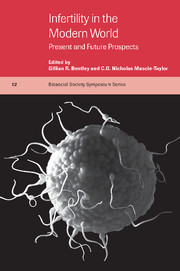Book contents
- Frontmatter
- Contents
- List of contributors
- 1 Introduction
- Part I Biomedical perspectives on fertility
- 2 Reproductive possibilities for infertile couples: present and future
- 3 Genetic influences on human infertility
- Part II Environmental influences on fertility
- Part III Social perspectives on infertility
- Index
3 - Genetic influences on human infertility
Published online by Cambridge University Press: 13 January 2010
- Frontmatter
- Contents
- List of contributors
- 1 Introduction
- Part I Biomedical perspectives on fertility
- 2 Reproductive possibilities for infertile couples: present and future
- 3 Genetic influences on human infertility
- Part II Environmental influences on fertility
- Part III Social perspectives on infertility
- Index
Summary
Abstract
A remarkable characteristic of human reproduction is the very high prevalence of spontaneous abortion, which frequently has been associated with major chromosomal abnormalities. The various forms of maternal–fetal red cell incompatibility and their potentially adverse effects on human fertility are well understood, and during the last 15 years of the twentieth century there was vigorous debate as to whether couples who share HLA-DR and/or HLA-B alleles are subfertile.
The most common genetic disorders associated with primary infertility in females are the chromosome abnormality Turner Syndrome (monosomy X), and Stein–Leventhal Syndrome (poly-cystic ovarian disease) which has a more complex and somewhat poorly defined genetic aetiology. A much wider spectrum of genetic defects can cause infertility in males, including Klinefelter Syndrome, X-autosome reciprocal translocation, Y-chromosome micro-deletions, congenital absence of the vas deferens, most commonly observed as part of the cystic fibrosis phenotype, and obstructive azoospermia in patients with Young Syndrome.
Successful pregnancies can be initiated in the majority of individuals with these disorders; for example, using donated oocytes or embryos in women with Turner Syndrome, and intracytoplasmic injection of sperm (ICSI) collected from men with Klinefelter Syndrome or congenital absence of the vas deferens. In some disorders, such as Y-linked microdeletions, there may be a high risk of transmission to progeny following fertilization via ICSI, which has caused concerns on dysgenic grounds. Preimplantation diagnosis has been used to monitor such embryos.
- Type
- Chapter
- Information
- Infertility in the Modern WorldPresent and Future Prospects, pp. 46 - 82Publisher: Cambridge University PressPrint publication year: 2000
- 5
- Cited by



